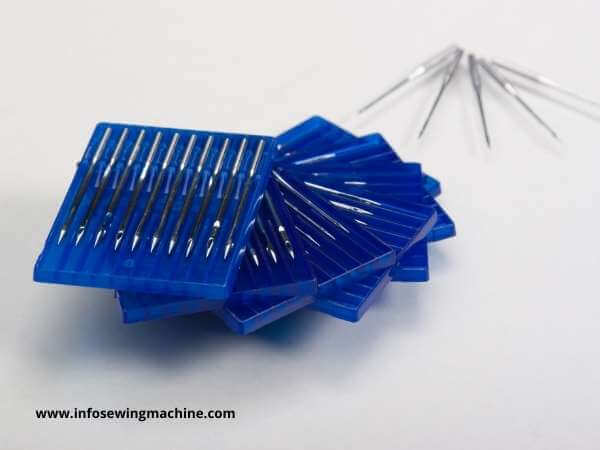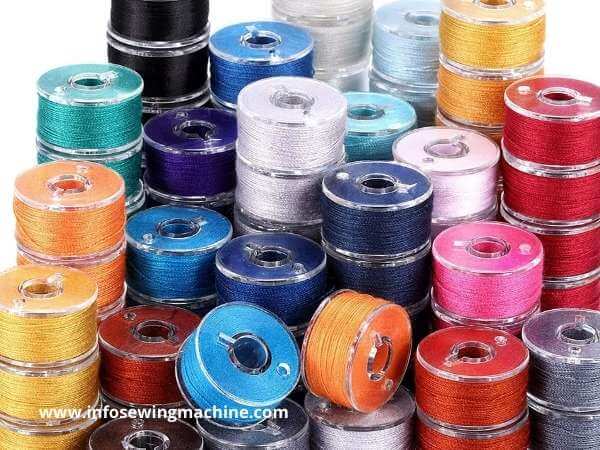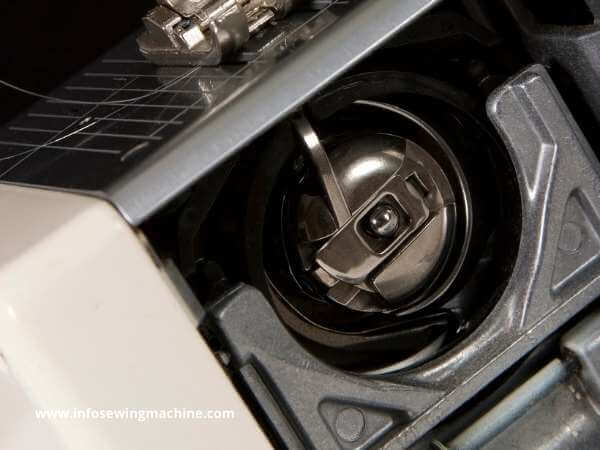A Complete Guide – What Is A Sewing Machine Bobbin
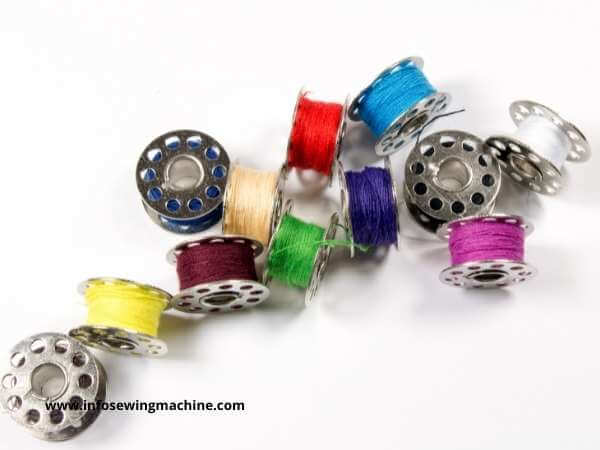
Bobbin refers to a round spool, usually made of metal, with thread wound around it. It is a compulsory part of the Sewing Machine.
Many new sewers and sewing machine owners spend the first few weeks of sewing learning how to Thread A Needle, Sew A Straight Stitch, Change Threads, Load A Bobbin, etc. Having these basic sewing skills is important to avoid making mistakes when you get started. But once your sewing machine runs smoothly, you may want to learn a few advanced techniques for extending its lifespan.
In this article, we will discuss about Sewing Machine Bobbin; What Is A Sewing Machine Bobbin? And how it works, etc.
What Is A Bobbin On A Sewing Machine?
A Bobbin is a small spool (or cylinder) onto which thread or yarn is wound. It stores the thread from which a sewing machine takes thread. It’s normally placed inside a sewing machine, so you don’t have to worry about thread getting tangled or caught on anything during normal sewing operations.
What Does A Bobbin Do?
Bobbins are used to feed the thread for stitching from the lower part of the Sewing Machine. The main purpose of the bobbin is to hold the thread below the Sewing Needle and makes loops with the thread coming out of the Sewing Needle for a perfect stitch. In other words, the sewing process can be done with the help of Bobbin.
Basics Of Bobbins For Sewing Machine
Mechanism of Bobbins may vary from brand to brand or Type of Sewing Machine.
Drop-In Bobbin Or Top Load Bobbin

In this mechanism, the bobbin can be fitted by dropping the bobbin in the bobbin case by only removing a plate below the Presser Foot. Place the plate back again to secure the bobbin. Then the thread is pulled from the bobbin through the Sewing Needle. The machine is ready to use the bobbin thread for the sewing process. Otherwise, you can check the user manual for proper threading instructions according to the brand of Sewing Machine.
Sewists most like Top Loading Bobbin because it is an easy bobbin loading system and a more modern option.
Front Load Bobbin
In this mechanism, the bobbin is fitted into the Bobbin Metal Case. The cover is removed from the Bobbin feed, and the metal case is loaded into the front of the Sewing Machine. Then the cover is put back in its place. The needle picks up at last thread to start the sewing process.

Most New Sewing Machines come with the Front Loading Bobbin system.
Types Of Bobbins
There are different types of Bobbin according to the composition of the market.
01. Metal Bobbins
These bobbins are the most common and are composed of treated steel. Metal Bobbins are preferred mostly over other bobbins.
02. Plastic Bobbins
These bobbins are also performing like Metal Bobbins and gaining daily popularity. They are inexpensive as well as durable.
03. Aluminum Bobbins
Aluminum bobbins spin faster than those made of other materials. Aluminum Bobbins often perform better than metal and plastic bobbins; however, it’s worthwhile noting that aluminum bobbins are much more fragile and easily damaged.
04. Megna Glide Covers Or PreWound Bobbins
These are like a bobbin barrel winded by a thread. These bobbins come with built-in tension. It is made of a magnetic core, which creates consistent stitches and prevents backlash. These bobbins can be recycled or disposed of after use. Color variation is limited with these kinds of bobbins, but mostly one shade can blend with several colors.
05. Factory-wound Bobbins
These are tighter winding bobbins, which can hold 25 to 30 yards of thread compared to the self-winding bobbins. The thread used in these bobbins is thinner than normal thread. These bobbins come with a plastic or cardboard side.
Are Metal Bobbins Better than Plastic?
Both Bobbin has their advantages and disadvantages. Plastic bobbins are so fragile that they can easily break. On the other hand, the metal bobbins are stronger, but there is a chance of thread getting stuck in the Bobbin, which causes increased tension. Or sometimes Bobbin jumps in the bobbin case.
The best choice is to use plastic bobbins for plastic cases and metal bobbins for metal cases.
Metal bobbins are expensive but tend to last longer, and plastic bobbins available at cheap prices
Can You Use Plastic Bobbins Instead of Metal?
You can use plastic bobbins instead of metal bobbins of the same size. But it would help if you avoided this as metal bobbins are heavier than plastic bobbins and need more tension. And more tension is not good for plastic Bobbin, which results in Bobbin Breaking or Bobbin Jamming.
What Is A Bobbin Winder?
A Bobbin Winder is specifically designed to wind the bobbin. It is part of the Sewing Machine. It winds thread from a large spool around the bobbin at a rotating speed.
How To Fill A Bobbin?
Regardless of the Mechanism Of Front Load or Top Load Bobbin, Bobbin winding with thread always goes the same way. Bobbin winding is tricky also. If winding does not go properly, it can cause problems like Bobbin Jamming, Thread Breaking, Needle Breaking, etc.
Be sure the thread feeds evenly from top to bottom around the bobbin shaft. Uneven bobbin winding can also cause Bobbin Thread to Brunch up under the fabric sewn.
You can use the Bobbin Winder for evenly winding thread around the bobbin. In the beginning, it winds thread quickly; as the bobbin winds down, it becomes slower until the last few turns and the bobbin stops.
Step By Step Guide To Install The Bobbin
After evenly winding the thread around the bobbin
- Open the bobbin door below the presser foot.
- Locate the hole in the bobbin spindle over the peg in the bobbin
- Pull out a little bit of thread outside the Bobbin.
- Slide the bobbin into the bobbin case
- There is a slit on the side of the bobbin case; now, pull the thread straight up through the slit of the bobbin.
- Turn the bobbin case with its back facing you, and keep the bobbin in place.
- Lift the lever located on the back of the bobbin case. Hold it until the bobbin is inserted properly in the bobbin place.
- Align the bobbin case to sit in the Slot of the Sewing Machine.
- Release the lever.
- Close the bobbin door which you have opened in the beginning.
How Can I Be Sure I’m Winding My Bobbin Correctly?
If the stitches are not going properly, it points to improper bobbin winding. Stretching in sewing stitches or a heap of threads also points the improper winding. Improper Bobbin Winding can also effect the tension of the thread.
What Holds A Bobbin In Place?
A bobbin case holds the bobbin in place. There are two types of bobbin cases.
- Removeable Bobbin Case
- Build in Bobbin Case
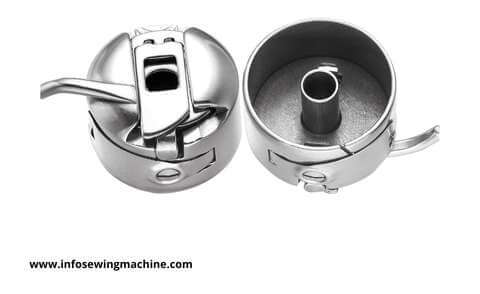
Bobbin Case for smoother sewing Stitches holds the tension from the bobbin and its internal parts.
Can You Use A Sewing Machine If You Don’t Have A Bobbin?
The Bobbin is the key to the sewing process of a Sewing Machine. A bobbin secures the thread and makes a perfect stitch in the sewing process. You can not use a sewing machine if you don’t have a bobbin. If you use a machine without a bobbin inserted, all the thread from the needle starts gathering around the lever of the Bobbin fitting area under the presser foot. This creates frustration as you have to remove all the threads from the place. This process is the time taken and messy.
Do All Bobbins Fit In All Sewing Machines?
No, All bobbins do not fit in all sewing machines. Every machine uses a specific type and size of the Bobbin. The wrong size or type of Bobbin will not work with the machine properly. You can read more about bobbins Are Sewing Machine Bobbins Universal?
Are Rusty Bobbins Really A Thing?
Sometimes because lack of care in storing Bobbin can cause rust on them, Rusty bobbins can ruin your project and sewing machine. Try to oil the rusty Bobbin and clean them before using. But if they still are not looking well, change the Bobbin with a new one.
Sewing Machine Bobbin Problems
The Bobbin may seem very small to some people, but it’s a big deal to someone who has to sew a lot of fabric. If your Bobbin runs out of thread, you have to stop sewing until you’ve refilled your Bobbin. The Bobbin should be almost full.
As mentioned earlier, bobbin problems occur when the bobbin threads do not line up correctly and lead to an imperfect stitch. Common causes of bobbin problems include:
- Incorrect bobbin thread type.
- Incorrect bobbin tension.
- Insufficient bobbin thread supply.
- Incorrect bobbin thread winding or rewinding.
A common problem with a sewing machine is the Bobbin winding up too tightly, creating the needle to jump around, making the seam uneven, and possibly even tearing the fabric. This happens because the machine uses friction between the top thread and the Bobbin to wind it around. The friction increases when the Bobbin is tightly wound, causing more threads to wrap around.
Also, consider the condition of the bobbin and bobbin cases. In case of a damaged Bobbin or bobbin case, changing the bobbin or bobbin case with a new one is recommended.
We recommend the bobbins be sorted into different color groups so that the thread can be easily distinguished by eye. Bobbins are kept in boxes in the sewing room or sewing cupboard.
Conclusion | What Is A Sewing Machine Bobbin
Sewing machine bobbins aren’t exactly a new idea. Bobbins have been around for hundreds of years. But with the rise of modern computerized machines and the advent of modern fabrics and threads, this sewing concept has become a key part of sewing.
In the article above, we tried to cover some of the basic benefits and features of sewing machine bobbins and explore how they can impact your sewing experience. We also tried to cover some things to consider when choosing the right sewing machine bobbin for your needs.
I hope this article has provided you with a few new ideas to add to your sewing machine bobbin knowledge! I wish you all the best with your stitching.
FAQs | What Is A Sewing Machine Bobbin
What are bobbins used for?
Bobbins are used to wind the lower thread for the sewing machine, and the sewing machine makes stitches by looping the lower thread from Bobbin along with the upper thread from the needle.
Can you use any bobbin in a sewing machine?
You can use any other bobbin slightly different from the actual bobbin recommended for the Sewing Machine. But using the incorrect type of bobbin may damage your fabric and sewing machine.
Can you sew without a bobbin in a sewing machine?
No, you can not sew without a bobbin installed in the sewing machine. If you do so, it can cause thread wrapping in the bobbin case below the needle.
Are all sewing bobbins the same size?
Not all sewing bobbins are not the same size; they are available in different sizes and materials like metal, plastic or pre-wound, etc.

